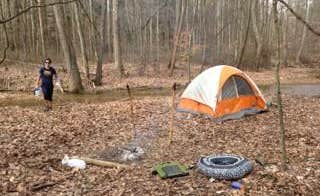Dispersed camping near Lebanon Junction, Kentucky provides backcountry opportunities across Kentucky and neighboring Indiana. The region's limestone karst topography creates unique underground formations and surface features that influence camping conditions. Summer temperatures typically range from 70-90°F with high humidity, while spring and fall offer milder conditions with temperatures between 50-75°F.
What to do
Explore hidden waterways: At Hoosier National Forest, campers can access secluded sections of the Ohio River watershed. "Big spot for almost any type of camper. Deep woods," notes Nathanyal C., highlighting the expansive nature of this less-traveled area.
Challenge yourself with elevation: The rugged terrain at Knobstone Trail provides serious hiking opportunities. "The KT is rugged and has lots of elevation gains over short distances. Everywhere you hike there are lovely vistas and lots of fossils on the trail and creek beds," explains Maris H., describing the geological features that make this area unique.
Night sky observation: The remote locations offer exceptional stargazing opportunities due to minimal light pollution. The deep darkness in backcountry areas creates optimal conditions for viewing constellations, particularly during new moon phases when skies are darkest.
What campers like
Natural isolation: Many campers appreciate the solitude available at Jackson Trailhead, where one reviewer notes, "There's parking after a decrepit gravel road and suitable for camping. There are campsites along the trail just have to find them." This primitive setting attracts those seeking minimal development.
Varied terrain: The topography provides diverse camping environments within relatively short distances. "The entire park is just beautiful. It's very family friendly and quiet. The sites are spacious, and there are a lot of nature things to do," Susan C. says about Knobstone Trail, highlighting the combination of scenic beauty and recreational opportunities.
Wildlife encounters: The region supports diverse fauna including white-tailed deer, wild turkeys, and numerous bird species. Proper food storage in animal-proof containers is essential, as wildlife activity increases during dawn and dusk hours at most dispersed sites.
What you should know
Water planning essential: Water sources vary significantly by location and season. "You're never too far from water, although the quality may differ depending on the time of year," advises a Knobstone Trail camper, emphasizing the need for filtration systems or carrying adequate supplies.
Navigation challenges: Many dispersed camping areas near Lebanon Junction have limited signage. "Maybe Google Maps took me to the wrong place. I drove back and forth on the road several times looking for this place," reports Desert B. about attempting to locate Knobstone Trail, underscoring the importance of bringing physical maps.
Seasonal insect concerns: Ticks are prevalent in warmer months. Use EPA-approved repellents containing at least 20% DEET, and perform regular tick checks after hiking through tall grass or wooded areas, particularly from April through September.
Tips for camping with families
Choose accessible sites: Some areas offer more family-friendly options with shorter hikes to campsites. "The entire park is just beautiful. It's very family friendly and quiet," notes a reviewer about Knobstone Trail, though families should still prepare for primitive conditions.
Pack appropriate clothing: Temperature fluctuations can be significant, especially in spring and fall. Layered clothing allows adjustment to changing conditions, with moisture-wicking base layers recommended due to the region's humidity levels.
Bring entertainment: With limited cell service in most dispersed camping areas near Lebanon Junction, plan screen-free activities for children. Field guides for local plant and animal identification can turn hikes into educational scavenger hunts.
Tips from RVers
Access limitations: Most dispersed camping near Lebanon Junction is not suitable for RVs. At First Creek Dispersed Camping, sites require "an enjoyable hike down into the First Creek, creek bed of Green River," according to Shelly S., indicating access is limited to those on foot.
Alternative options: RVers should consider established campgrounds instead of dispersed areas. The primitive road conditions described as "decrepit gravel" at Jackson Trailhead indicate that even vehicle access to trailheads may be challenging for larger vehicles.
Preparation requirements: If attempting to reach dispersed camping trailheads, RVers should carry emergency supplies including basic tools, extra water, and communication devices that work without cell service. Road conditions deteriorate significantly after rainfall, potentially creating impassable mud situations.


